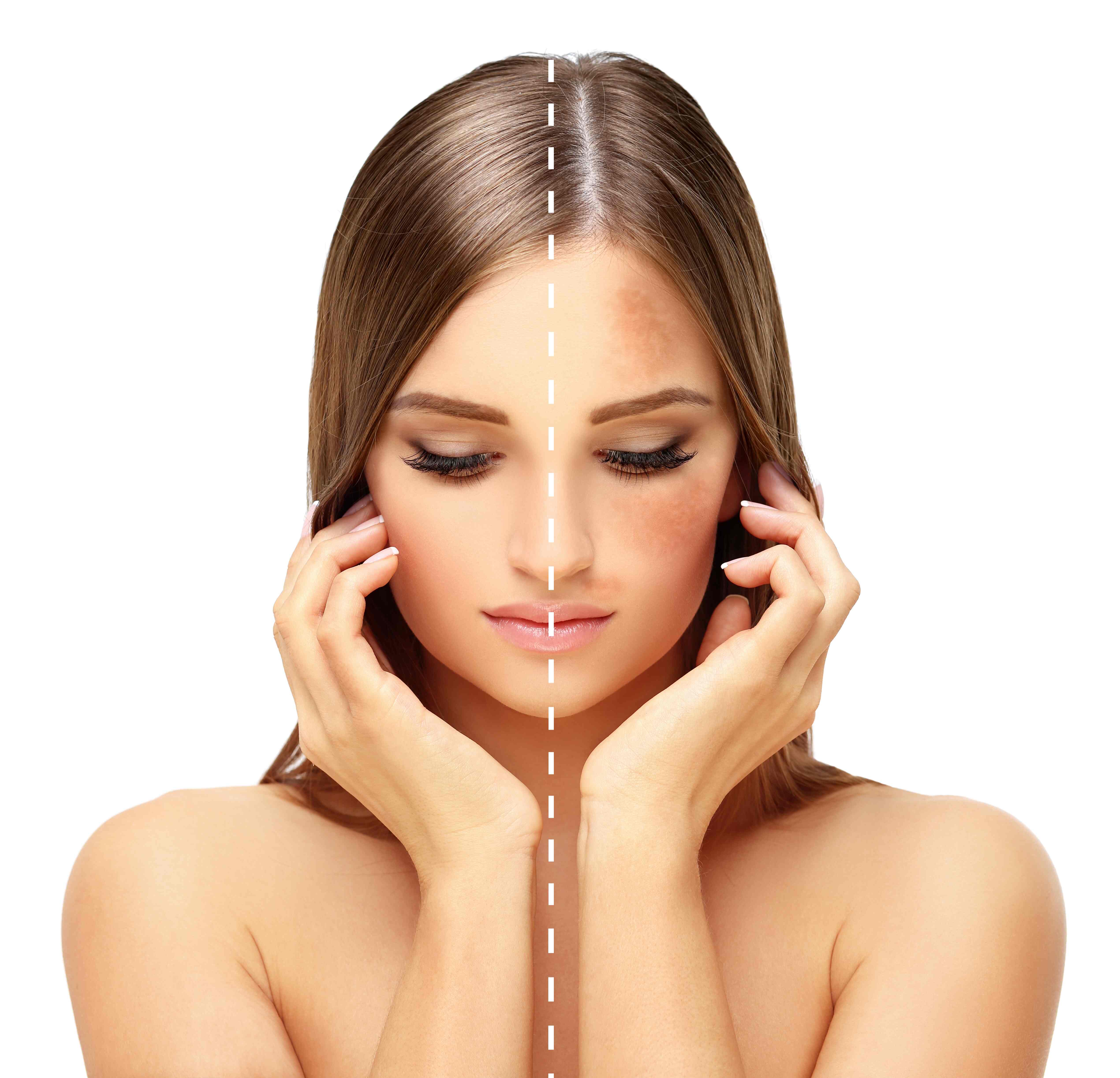8 Treatment Options for Hyperpigmentation
Written By: Dr. Eman AboElnagah
Updated On:January 26, 2025

What is Hyperpigmentation?
A darker area of skin caused by excessive melanin production is referred to medically as hyperpigmentation. Everything from sun damage and hormone swings to acne scars might be the culprit. You are not alone if you are struggling with hyperpigmentation. A variety of various treatments are available for the widespread skin problem known as hyperpigmentation.
Hyperpigmentation Treatment Options
Face Acids for Treating Hyperpigmentation
The top layer of your skin is exfoliated by face acids or skin acids. As a result of exfoliation, new skin cells replace the old ones in your body. Your skin becomes smoother overall and helps to balance out the tone.
A few well-liked choices of face acids include the following:
- alpha hydroxy acids
- azelaic acid
- kojic acid
- salicylic acid
- vitamin C or l-ascorbic acid
On fairer skin tones, face acids are effective for treating moderate hyperpigmentation.
Lightening Creams for Treating Hyperpigmentation
Using specific components, whitening creams are over-the-counter (OTC) treatments that can reduce pigmentation. Numerous of these lotions may be obtained with stronger prescription dosages.
They're often used once or twice a day to gradually lighten the skin. Gel-like topical lightening medications are also available.
The following list of substances is typical in lightening products: Vitamin B-3 found and licorice extract.
For areas impacted by melasma or age spots, whitening lotions or gels work well. On the majority of skin types, they also work well for spots of discoloration.
Retinoids for Treating Hyperpigmentation
Retinoids, which are derived from vitamin A, are among the most traditional OTC skin care components. Their tiny molecular size lets them treat the skin layers underneath your epidermis by deeply penetrating the skin. Discuss the prescription retinoid tretinoin (Retin-A) with your dermatologist if you still don't observe any improvement after a few months.
All skin tones may be safe for OTC retinoids, but you should double-check with your dermatologist if you have darker skin and want to use these products frequently. Hyperpigmentation is less frequently treated with retinoids than wrinkles are crucial. Retinoids might not be the ideal first-line therapy in this situation.
Chemical Peels for Treating Hyperpigmentation
Face, hands, and neck areas can undergo chemical peels as aesthetic procedures to treat hyperpigmentation. Chemical peels are applied to the skin to enhance its look or feel. The skin will exfoliate and finally peel off during this operation when chemical solutions are introduced to the region being treated. After that, the new skin that has emerged is frequently softer, less wrinkled, and may be damaged less.
You might want to think about visiting your dermatologist's office for a professional-grade peel. These are effective and produce fast effects.
Chemical peels might not be your greatest medical option if you often spend time in the sun. Your skin becomes more susceptible to the sun's rays after chemical peels.
Laser Peels for Treating Hyperpigmentation
Focused beams of light are employed in laser peel treatments to reduce the presence of hyperpigmentation.
Both ablative and non-ablative lasers are also available.
The most potent laser procedures eliminate skin layers and are referred to as ablative lasers. Conversely, non-ablative treatments target the dermis to stimulate collagen production and achieve skin tightening advantages.
Although ablative lasers are more powerful, they might have more negative effects. Both eliminate substances from your skin so that fresh skin cells regenerate tighter and more toned. Nonetheless, the best method for skin resurfacing doesn't exist. For those with fair skin, ablative lasers could be more effective. Non-ablative versions may result in skin darkening rather than lightening for certain persons. The ideal solution for your skin will be determined after your dermatologist and you evaluate your discoloration and general skin tone.
Intense Pulsed Light (IPL) Therapy for Treating Hyperpigmentation
Non-ablative (fractional) laser therapy includes IPL therapy. IPL treatment, sometimes referred to as a photo facial, promotes collagen development in the dermis. Usually, several sessions are necessary.
IPL is used to treat general pigmentation problems, although flat areas react particularly well to this therapy. Additionally, it can aid in lessening the visibility of wrinkles, spider veins, and enlarged pores.
Microdermabrasion for Treating Hyperpigmentation
Microdermabrasion is an office technique used to treat hyperpigmentation that only affects the epidermis (superficial scarring).
Your dermatologist will use drill-like handheld equipment with a wire brush or another abrasive attachment throughout the operation. The epidermis is then quickly yet delicately removed by swiping the instrument across your skin.
To get the best results, you might require many sessions.
Dermabrasion for Treating Hyperpigmentation
Dermabrasion removes some of your epidermis as well, but it also affects a portion of your dermis. Dermabrasion has traditionally been used to treat difficulties with texture, while it is occasionally utilized to reduce wrinkles. These comprise aging marks, scars from acne, scars from injuries, UV damage, and scars from chickenpox.
Your dermatologist will use a portable device similar to a drill with a wire brush or other abrasive attachment, much like with microdermabrasion. They'll swiftly but delicately remove your whole epidermis and the top layer of your dermis by moving the instrument over your skin.
In conclusion, your dermatologist will work with you to develop an efficient treatment plan and can help you identify the cause of your hyperpigmentation. Whatever course of therapy you ultimately decide on, it's crucial to protect your skin against extra UV deterioration and hyperpigmentation.
References
Perez-Bernal, A., Munoz-Perez, M. A., & Camacho, F. (2000). Management of facial hyperpigmentation. American journal of clinical dermatology, 1, 261-268.
Garg, V. K., Sinha, S., & Sarkar, R. (2009). Glycolic acid peels versus salicylic–mandelic acid peels in active acne vulgaris and post‐acne scarring and hyperpigmentation: a comparative study. Dermatologic Surgery, 35(1), 59-65.
Cayce, K. A., McMichael, A. J., & Feldman, S. R. (2004). Hyperpigmentation: an overview of the common afflictions. Dermatology nursing, 16(5), 401.
Ferreira, J. A. (1976). Dermabrasion of the skin: Prevention and/or treatment of hyperpigmentation. Aesthetic Plastic Surgery, 1, 381-389.
Kauvar, A. N. (2012). Successful treatment of melasma using a combination of microdermabrasion and Q‐switched Nd: YAG lasers. Lasers in surgery and medicine, 44(2), 117-124.
Ho, W. S., Chan, H. H., Ying, S. Y., Chan, P. C., Burd, A., & King, W. W. (2003). Prospective study on the treatment of postburn hyperpigmentation by intense pulsed light. Lasers in Surgery and Medicine: The Official Journal of the American Society for Laser Medicine and Surgery, 32(1), 42-45.
Woolery-Lloyd, H., & Kammer, J. N. (2011, September). Treatment of hyperpigmentation. In Seminars in cutaneous medicine and surgery (Vol. 30, No. 3, pp. 171-175). WB Saunders.
Meet our doctors from the Dermatology & Aesthetics department









